Chitwan Saharia
TryOnDiffusion: A Tale of Two UNets
Jun 14, 2023



Abstract:Given two images depicting a person and a garment worn by another person, our goal is to generate a visualization of how the garment might look on the input person. A key challenge is to synthesize a photorealistic detail-preserving visualization of the garment, while warping the garment to accommodate a significant body pose and shape change across the subjects. Previous methods either focus on garment detail preservation without effective pose and shape variation, or allow try-on with the desired shape and pose but lack garment details. In this paper, we propose a diffusion-based architecture that unifies two UNets (referred to as Parallel-UNet), which allows us to preserve garment details and warp the garment for significant pose and body change in a single network. The key ideas behind Parallel-UNet include: 1) garment is warped implicitly via a cross attention mechanism, 2) garment warp and person blend happen as part of a unified process as opposed to a sequence of two separate tasks. Experimental results indicate that TryOnDiffusion achieves state-of-the-art performance both qualitatively and quantitatively.
Synthetic Data from Diffusion Models Improves ImageNet Classification
Apr 17, 2023Abstract:Deep generative models are becoming increasingly powerful, now generating diverse high fidelity photo-realistic samples given text prompts. Have they reached the point where models of natural images can be used for generative data augmentation, helping to improve challenging discriminative tasks? We show that large-scale text-to image diffusion models can be fine-tuned to produce class conditional models with SOTA FID (1.76 at 256x256 resolution) and Inception Score (239 at 256x256). The model also yields a new SOTA in Classification Accuracy Scores (64.96 for 256x256 generative samples, improving to 69.24 for 1024x1024 samples). Augmenting the ImageNet training set with samples from the resulting models yields significant improvements in ImageNet classification accuracy over strong ResNet and Vision Transformer baselines.
Denoising Diffusion Probabilistic Models for Robust Image Super-Resolution in the Wild
Feb 15, 2023Abstract:Diffusion models have shown promising results on single-image super-resolution and other image- to-image translation tasks. Despite this success, they have not outperformed state-of-the-art GAN models on the more challenging blind super-resolution task, where the input images are out of distribution, with unknown degradations. This paper introduces SR3+, a diffusion-based model for blind super-resolution, establishing a new state-of-the-art. To this end, we advocate self-supervised training with a combination of composite, parameterized degradations for self-supervised training, and noise-conditioing augmentation during training and testing. With these innovations, a large-scale convolutional architecture, and large-scale datasets, SR3+ greatly outperforms SR3. It outperforms Real-ESRGAN when trained on the same data, with a DRealSR FID score of 36.82 vs. 37.22, which further improves to FID of 32.37 with larger models, and further still with larger training sets.
Character-Aware Models Improve Visual Text Rendering
Dec 20, 2022



Abstract:Current image generation models struggle to reliably produce well-formed visual text. In this paper, we investigate a key contributing factor: popular text-to-image models lack character-level input features, making it much harder to predict a word's visual makeup as a series of glyphs. To quantify the extent of this effect, we conduct a series of controlled experiments comparing character-aware vs. character-blind text encoders. In the text-only domain, we find that character-aware models provide large gains on a novel spelling task (WikiSpell). Transferring these learnings onto the visual domain, we train a suite of image generation models, and show that character-aware variants outperform their character-blind counterparts across a range of novel text rendering tasks (our DrawText benchmark). Our models set a much higher state-of-the-art on visual spelling, with 30+ point accuracy gains over competitors on rare words, despite training on far fewer examples.
Imagen Editor and EditBench: Advancing and Evaluating Text-Guided Image Inpainting
Dec 13, 2022



Abstract:Text-guided image editing can have a transformative impact in supporting creative applications. A key challenge is to generate edits that are faithful to input text prompts, while consistent with input images. We present Imagen Editor, a cascaded diffusion model built, by fine-tuning Imagen on text-guided image inpainting. Imagen Editor's edits are faithful to the text prompts, which is accomplished by using object detectors to propose inpainting masks during training. In addition, Imagen Editor captures fine details in the input image by conditioning the cascaded pipeline on the original high resolution image. To improve qualitative and quantitative evaluation, we introduce EditBench, a systematic benchmark for text-guided image inpainting. EditBench evaluates inpainting edits on natural and generated images exploring objects, attributes, and scenes. Through extensive human evaluation on EditBench, we find that object-masking during training leads to across-the-board improvements in text-image alignment -- such that Imagen Editor is preferred over DALL-E 2 and Stable Diffusion -- and, as a cohort, these models are better at object-rendering than text-rendering, and handle material/color/size attributes better than count/shape attributes.
Imagen Video: High Definition Video Generation with Diffusion Models
Oct 05, 2022

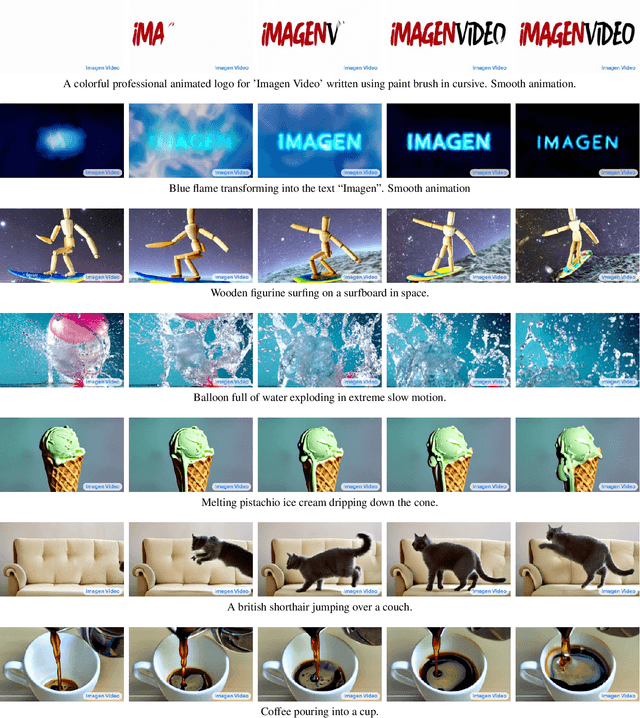
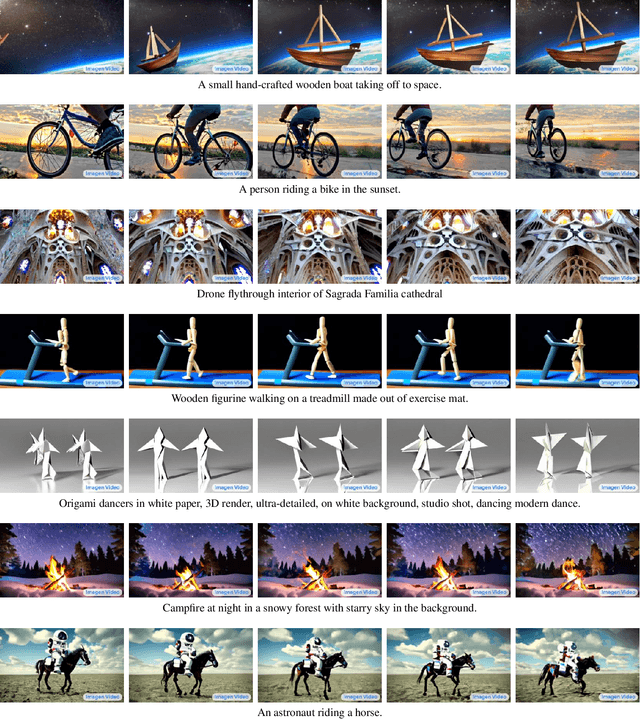
Abstract:We present Imagen Video, a text-conditional video generation system based on a cascade of video diffusion models. Given a text prompt, Imagen Video generates high definition videos using a base video generation model and a sequence of interleaved spatial and temporal video super-resolution models. We describe how we scale up the system as a high definition text-to-video model including design decisions such as the choice of fully-convolutional temporal and spatial super-resolution models at certain resolutions, and the choice of the v-parameterization of diffusion models. In addition, we confirm and transfer findings from previous work on diffusion-based image generation to the video generation setting. Finally, we apply progressive distillation to our video models with classifier-free guidance for fast, high quality sampling. We find Imagen Video not only capable of generating videos of high fidelity, but also having a high degree of controllability and world knowledge, including the ability to generate diverse videos and text animations in various artistic styles and with 3D object understanding. See https://imagen.research.google/video/ for samples.
Re-Imagen: Retrieval-Augmented Text-to-Image Generator
Oct 01, 2022



Abstract:Research on text-to-image generation has witnessed significant progress in generating diverse and photo-realistic images, driven by diffusion and auto-regressive models trained on large-scale image-text data. Though state-of-the-art models can generate high-quality images of common entities, they often have difficulty generating images of uncommon entities, such as `Chortai (dog)' or `Picarones (food)'. To tackle this issue, we present the Retrieval-Augmented Text-to-Image Generator (Re-Imagen), a generative model that uses retrieved information to produce high-fidelity and faithful images, even for rare or unseen entities. Given a text prompt, Re-Imagen accesses an external multi-modal knowledge base to retrieve relevant (image, text) pairs, and uses them as references to generate the image. With this retrieval step, Re-Imagen is augmented with the knowledge of high-level semantics and low-level visual details of the mentioned entities, and thus improves its accuracy in generating the entities' visual appearances. We train Re-Imagen on a constructed dataset containing (image, text, retrieval) triples to teach the model to ground on both text prompt and retrieval. Furthermore, we develop a new sampling strategy to interleave the classifier-free guidance for text and retrieval condition to balance the text and retrieval alignment. Re-Imagen achieves new SoTA FID results on two image generation benchmarks, such as COCO (ie, FID = 5.25) and WikiImage (ie, FID = 5.82) without fine-tuning. To further evaluate the capabilities of the model, we introduce EntityDrawBench, a new benchmark that evaluates image generation for diverse entities, from frequent to rare, across multiple visual domains. Human evaluation on EntityDrawBench shows that Re-Imagen performs on par with the best prior models in photo-realism, but with significantly better faithfulness, especially on less frequent entities.
Photorealistic Text-to-Image Diffusion Models with Deep Language Understanding
May 23, 2022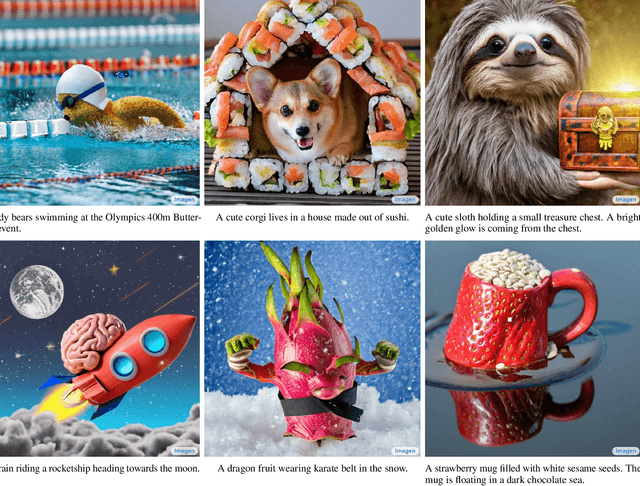
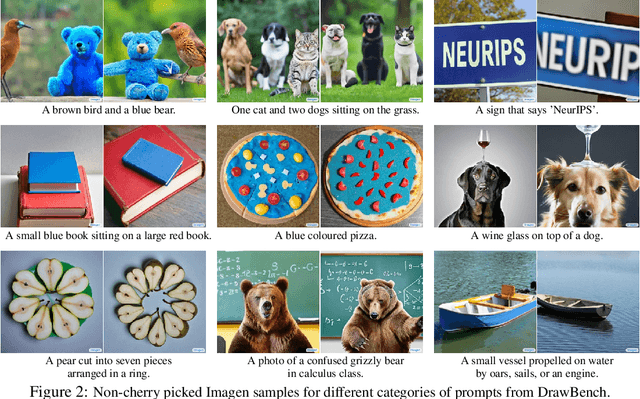
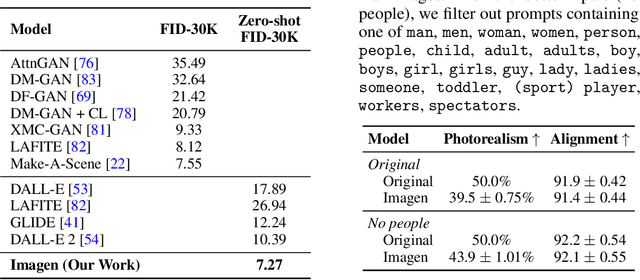

Abstract:We present Imagen, a text-to-image diffusion model with an unprecedented degree of photorealism and a deep level of language understanding. Imagen builds on the power of large transformer language models in understanding text and hinges on the strength of diffusion models in high-fidelity image generation. Our key discovery is that generic large language models (e.g. T5), pretrained on text-only corpora, are surprisingly effective at encoding text for image synthesis: increasing the size of the language model in Imagen boosts both sample fidelity and image-text alignment much more than increasing the size of the image diffusion model. Imagen achieves a new state-of-the-art FID score of 7.27 on the COCO dataset, without ever training on COCO, and human raters find Imagen samples to be on par with the COCO data itself in image-text alignment. To assess text-to-image models in greater depth, we introduce DrawBench, a comprehensive and challenging benchmark for text-to-image models. With DrawBench, we compare Imagen with recent methods including VQ-GAN+CLIP, Latent Diffusion Models, and DALL-E 2, and find that human raters prefer Imagen over other models in side-by-side comparisons, both in terms of sample quality and image-text alignment. See https://imagen.research.google/ for an overview of the results.
Deblurring via Stochastic Refinement
Dec 28, 2021



Abstract:Image deblurring is an ill-posed problem with multiple plausible solutions for a given input image. However, most existing methods produce a deterministic estimate of the clean image and are trained to minimize pixel-level distortion. These metrics are known to be poorly correlated with human perception, and often lead to unrealistic reconstructions. We present an alternative framework for blind deblurring based on conditional diffusion models. Unlike existing techniques, we train a stochastic sampler that refines the output of a deterministic predictor and is capable of producing a diverse set of plausible reconstructions for a given input. This leads to a significant improvement in perceptual quality over existing state-of-the-art methods across multiple standard benchmarks. Our predict-and-refine approach also enables much more efficient sampling compared to typical diffusion models. Combined with a carefully tuned network architecture and inference procedure, our method is competitive in terms of distortion metrics such as PSNR. These results show clear benefits of our diffusion-based method for deblurring and challenge the widely used strategy of producing a single, deterministic reconstruction.
Palette: Image-to-Image Diffusion Models
Nov 10, 2021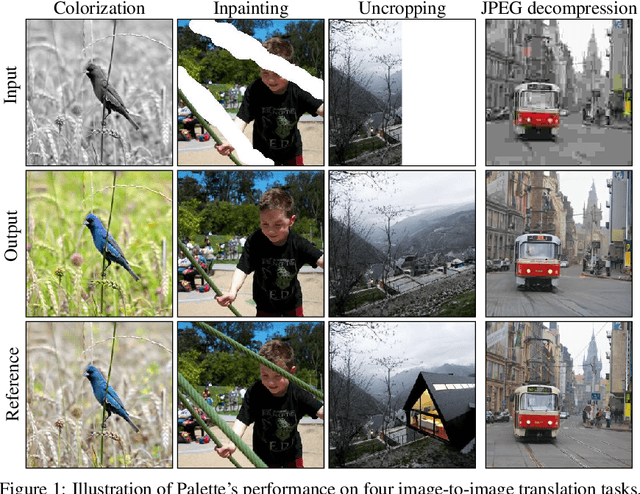



Abstract:We introduce Palette, a simple and general framework for image-to-image translation using conditional diffusion models. On four challenging image-to-image translation tasks (colorization, inpainting, uncropping, and JPEG decompression), Palette outperforms strong GAN and regression baselines, and establishes a new state of the art. This is accomplished without task-specific hyper-parameter tuning, architecture customization, or any auxiliary loss, demonstrating a desirable degree of generality and flexibility. We uncover the impact of using $L_2$ vs. $L_1$ loss in the denoising diffusion objective on sample diversity, and demonstrate the importance of self-attention through empirical architecture studies. Importantly, we advocate a unified evaluation protocol based on ImageNet, and report several sample quality scores including FID, Inception Score, Classification Accuracy of a pre-trained ResNet-50, and Perceptual Distance against reference images for various baselines. We expect this standardized evaluation protocol to play a critical role in advancing image-to-image translation research. Finally, we show that a single generalist Palette model trained on 3 tasks (colorization, inpainting, JPEG decompression) performs as well or better than task-specific specialist counterparts.
 Add to Chrome
Add to Chrome Add to Firefox
Add to Firefox Add to Edge
Add to Edge